What Do Catfish Eat?
As an Amazon Associate I earn from qualifying purchases.
Catfish are common fish species that are found in most parts of the world and there are over 3,000 subspecies. They are called catfish because of their barbels that resemble cat whiskers. This group of fish is members of the ray-finned fish. They are easily identified by their whisker-like barbels and they do not have any scales.
Catfish are some of the toughest freshwater fish species in existence. They can survive with very little oxygen and water. In drought conditions, this fish species is even known to dig holes underneath rivers so they can hide out until the rainy season arrives again. They also follow a remarkably flexible diet which is exactly what enables them to survive in tough conditions.
What Do Catfish Eat?
Most species of catfish are omnivorous. They eat a huge variety of food and can also feed on the decayed matter. Some species such as the Loricariidae catfish do however prefer foods like wood and algae above other types of food. Here is a quick look at the most common foods this fish species enjoy eating:
Commercial fish food
Catfish can eat just about any commercial fish food you offer them. For fry, high protein fish flakes are an ideal food source. For larger catfish, other commercial fish foods such as pellets are also a perfect food to offer to keep them healthy.
Fish and fish eggs
Catfish love to hunt for other fish species. They usually eat fish that are much smaller than they are but can also nibble at carcasses of larger fish to consume them. Most catfish are also cannibalistic. They will feed on smaller catfish and in catfish farms, cannibalism is a serious concern while raising larvae and fry.
Insects
Catfish will eat all sorts of insects that live or fall into the water. Young catfish, mostly feed on aquatic insects such as dragonfly larvae, water beetles, fly larvae, mosquito larvae, and others. You can use all sorts of insects such as crickets, grasshoppers, and earthworms as bait to catch catfish.
Crustaceans
This large fish species will also feed on various crustaceans they find in their natural environment. Animals such as crabs, decapods, lobsters, procambium, crawfish, cherax, water flies, water fleas, isopods, and many others are terrific foods to offer this fish species.
Aquatic plants
Catfish also eat plant matter. They will feed on aquatic plants that grow in the water such as algae, lotus plants, water lettuce, and many others. They may also feed on non-aquatic plants that happen to fall into the water such as grasses and soft leaves. This fish species can also feed on aquatic plant matter called detritus.
Fruits and vegetables
Pet owners are often advised to offer a pet catfish some fruits and vegetables to ensure that they get enough nutrients. You can offer them certain veggies raw or even cooked and cooled. If you cannot find natural algae or detritus to feed your catfish, you can also supplement them by offering them fruits and veggies such as apples, bananas, strawberries, broccoli, cabbage, and many other foods.
Blood
Some catfish species like the Candiru are parasitic. This fish species will latch onto its prey and feed on the blood of its host.
Small animals
Catfish are also fond of catching and eating small animals such as mice, rats, lizards, small birds, pigeons, frogs, and many others. They often catch these animals when they fall into the water or catfish may snatch animals like frogs or birds of the riverbank or from above the water.
Carrion
Catfish love to eat carrion meat. They will feed on just about any dead animal they find drifting about the water. Catfish may even scavenge on the carcass of larger animals such as cows or deer and they are happy to consume meat that has become slightly decayed.
Diet Variation
Catfish are detritus feeders which mean they can eat almost any food they can find at the base of a tank or on the river floor. They will also eat just about any type of fresh food they can find including fruits, veggies, and grains. In harsh conditions, they will eat just about anything they can find.
How to Feed Catfish?
Catfish are very easy to feed because they feed on fresh food as well as detritus and carrion meat. To feed catfish, you can simply dunk some food in the tank. This fish species can eat food from the water surface or they can feed off the tank floor and they are happy to eat almost anything they can find.
What Do Catfish Eat In the Wild?
In the wild, they eat what is available to them. Some seasons, they may focus on larger foods such as small mammals, crustaceans, fish or plant matter. In tough times, they can adapt to survive on detritus or carrion meat.
What Do Catfish Eat in Captivity?
In captivity, this fish species is often kept healthy by offering them a combination of commercial fish foods, an insect or two per week, some algae and detritus they find in the tank as well as other fruits and veggies you may introduce.
What Do Baby Catfish Eat?
New hatchling catfish are called larvae. When the catfish start to mature a bit, they are called fry. Young catfish mainly focus on smaller foods that are easily acquired such as algae, plant matter, detritus, crustaceans, fish larvae, and many others. They also have cannibalistic tendencies and are happy to eat one another.
How Much Do Catfish Eat?
As a rule of thumb, a catfish needs to eat about 2.5% of its body weight per day. This can however be tough to determine if you do not have a scale. To see if your catfish is getting enough food, you can simply keep an eye on it. Add its food to the tank and keep an eye on your catfish. If it consumes all food within minutes then you should add more food. If too much food is leftover, you can clear the tank and reduce the amount of food you offer daily.
How Often Do Catfish Eat?
Catfish are at their most active in summer. The warmth of the water boosts their metabolism and they start to eat much more compared to other seasons. Ideally, you should feed this fish species once per day, or seven times per week. They can however survive relatively long without feeding any food at all as long as their bodies can enter a hibernated state if the water is scarce.
Do Catfish Bite?
This fish species is relatively harmless to humans. They do not have teeth but do have a hard file like gums that can be used to grind down food. They also have sharp talons on some of their fins that they can use to sting you. These stings are however non-venomous and won’t do much harm.
Do Catfish Eat Frogs?
Catfish do enjoy eating frogs and tadpoles. Frogs and tadpoles are a good food source since catfish can easily sneak up on these reptiles in the water to catch and eat them. They will also feed on the carcasses of frogs that they might find floating about the river or dam.
Do Catfish Eat Other Fish?
Yes, catfish do eat any type of fish that are small enough to fit into their mouths. They eat a variety of fish species including their own species.
Amazon and the Amazon logo are trademarks of Amazon.com, Inc, or its affiliates.
What Do Catfish Eat?
Boat Safe is a community supported site. We may earn commission from links on this page, but we have confidence in all recommended products.
There is a reason that so many catfish anglers argue about the best bait to use. There are numerous kinds of bait that work very well to catch catfish. Some anglers swear by stink baits and dip baits. Some believe live catfish bait like fish and night crawlers are the best. Others would prefer cut baits for catfish. And of course there are those who will fish with chicken livers and hot dogs.
Many catfish in nature are omnivores. Others are what is known as opportunistic feeders. That means if food is presented to them they’ll eat it no matter what it is. Some species are only carnivorous. That’s why the range of bait that you can use to catch them is so extreme. It actually gets goofy sometimes. There are anglers who will swear by using Ivory soap to catch catfish. If you can use something that isn’t even food as bait, you can tell that catfish are not picky eaters.
Around the world you can find catfish species that are almost exclusively herbivorous. That means their diet is almost entirely made up of plant matter. There are also some species of catfish that are parasitic. That means they feed on the blood of other fish. These species don’t typically live in North America.
The whiskers on a catfish’s face are called barbels. Despite widespread belief, they are not dangerous. Instead, they are used by the fish to find food. Barbels are lined with sensory cells very similar to taste buds. Even in the mud a catfish can use these to taste food.
Though many catfish species are bottom feeders, not all of them are. How and what a catfish eats very much depends on the body of water that it lives in. Many catfish are happy to eat food floating on the surface of water.
Most anglers in North America catch the big three species of catfish. Those are blue catfish, channel catfish, and flathead catfish. But there are many other species in North America as well. Bullhead catfish are also popular with many anglers. That said, they are much smaller and not as widespread. What catfish eat is as diverse as the many species themselves.
Blue Catfish
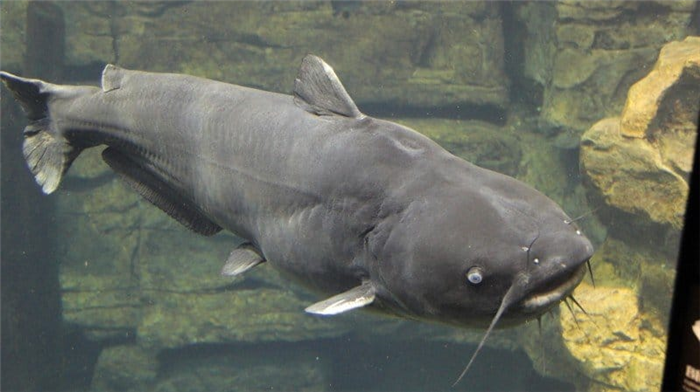
The largest catfish you will find in North America is the blue catfish. Trophy blues can grow to over 100 lbs. As you can imagine, their diet reflects their large size. In fact, there is very little a blue catfish will not eat. They feed on crustaceans such as crabs and crayfish. They will also eat clams and mussels. Blue catfish are also very fond of eating other fish. Small to medium bait fish are a favorite of blues. They’re not opposed to even eating other blue catfish if the opportunity arises.
Because blue catfish are opportunistic feeders, they may also eat unusual items. Researchers have uncovered a large variety of bizarre items inside blue catfish stomachs. That includes things like surgical gloves, metal, and even sewage.
Surprisingly, the main part of a blue catfish’s diet is vegetation. In fact, 50% of what they eat is vegetable matter. As they age and grow larger, they do focus on larger fish as prey, however. Large blues are often apex predators where they live.
Flathead Catfish
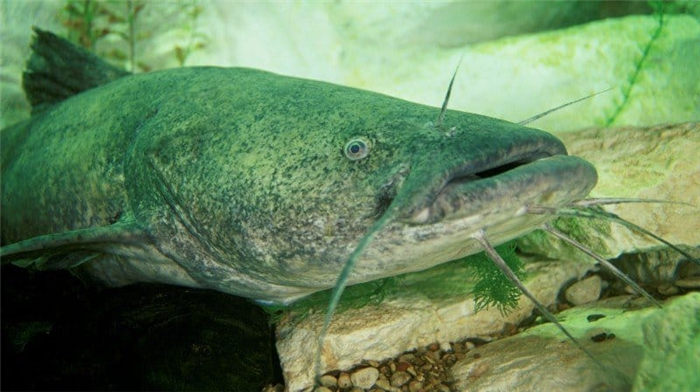
Flathead catfish have one of the more limited diets of all catfish. On occasion they will eat things like insects and crustaceans. Such variety is much more common in young flatheads. They are also fond of small fish as well. Minnows, bluegill, small perch, and other fish like that. Shad and bass are also favorites of flatheads as they age. Once they have matured flatheads will almost only feed on live fish.
Flatheads can get very large. One of the largest on record was over 5 feet long and 123 pounds. That means the fish they prey on can be large as well.
Channel Catfish
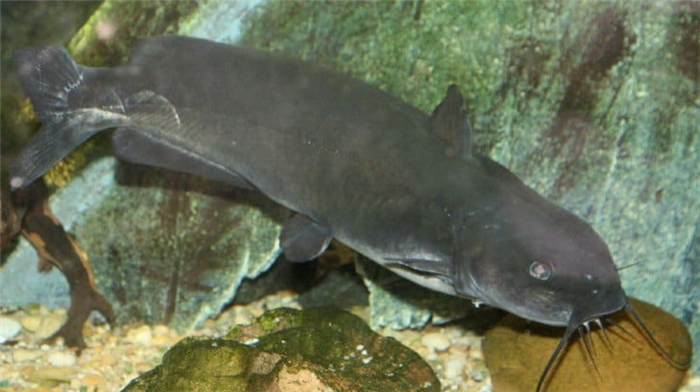
Channel catfish are the most opportunistic of the big three species. Channel cats will eat insects and small invertebrates. They’ll eat fish, snails, clams, and mollusks. They will even eat small mammals if they can get a hold of them. Some people have even seen channel catfish pluck birds off the surface of the water. Channel cats don’t care if their food is alive or dead.
If any kind of meat or living tissue is not available, channel catfish may also eat vegetation. Things like fruit or berries that fall into the water are fair game. Some aquatic plants are also eaten by catfish. Nearly anything can serve as a food source for channel catfish.
Bullhead Catfish
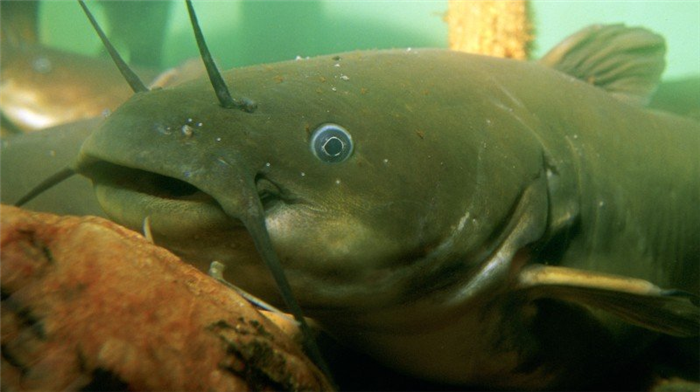
Bullhead catfish are scavengers and will eat most anything live or dead off the bottom. Because they are smaller than blue catfish or channel catfish, they will eat smaller prey. Small insects, crayfish, small fish are all in a bullhead catfish’s diet.
Young Catfish
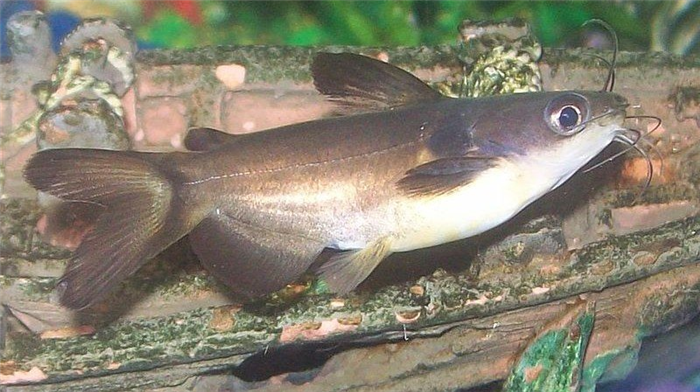
When catfish are still just little fries, they have to eat a suitably sized diet. That often means insect larvae and nymphs in the water. As they grow they may start eating small invertebrates. Typically, a young catfish will eat anything that doesn’t have a backbone. That includes things as large as young crayfish. Even at this young age, many catfish are not very choosy.
Farmed Catfish
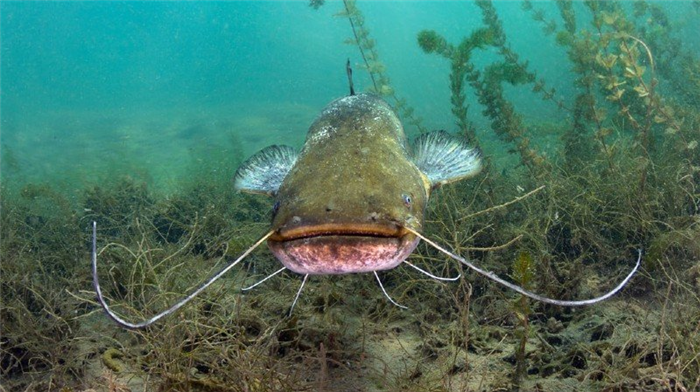
If you’re in the market for fishing at a catfish farm, expect a different diet. Farm-raised catfish have supplemented diets. They typically eat a pellet-based protein feed. Catfish pellets are usually around 30% protein. They’re also designed to float in warmer water and sink as it gets colder. This allows them to stay at an optimal depth for the catfish to eat. Of course, being opportunistic, they will eat most everything else they can find as well.
Depending on the farm, catfish can have their diet supplemented with many other items. Farmers who raise chickens and catfish often boil eggs for the catfish. This is pure protein and is a good food for any catfish. They will also eat other farm-raised fish like shad or tilapia even.
As you can see, what catfish eat is very diverse. What one wants to eat may not be appealing to another. That’s true even from one location to the next. That’s also what makes catching them so much fun. There are so many options for attracting them. It can really be exciting trying to master the best bait and approach.
About Ian
My grandfather first took me fishing when I was too young to actually hold up a rod on my own. As an avid camper, hiker, and nature enthusiast I’m always looking for a new adventure.
Curious Catfish Facts Explained: What Do Catfish Eat?
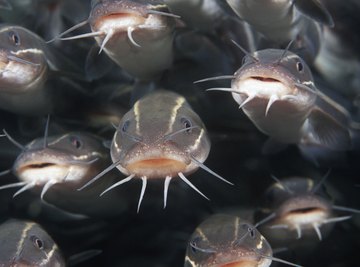
Show all photos 1
Published on Oct 18, 2021
Get inspiration for education!
Subscribe for virtual tools, STEM-inspired play, creative tips and more
The catfish is of the order Siluriformes, named because of their barbles which look like the whiskers of a cat.
There are many types of catfish like blue catfish, bullhead catfish, flathead catfish, channel catfish, which are available in different sizes and behavior. A few of the largest species of catfish that are alive are the Mekong Giant Catfish, the Wels Catfish, and the Paraiba Catfish (which lives in South America).
Catfish shows a variety of feeding habits and are also a diverse group of fishes. Some of them grow to be a herbivore or a scavenger, some of them even possess the ability to swallow one fish as a whole or even some other prey as well. Currently, there is an estimation of 29,000 catfish species present in the world. Catfish’s entire body is covered with taste buds because there are no scales on its skin and can detect chemicals in the water and respond to touch. These sensory organs are present on barbels. Catfish are freshwater fish and are found in freshwater lakes, rivers, ponds, farm ponds, channels. Catfish feed on swallowing as they had no teeth to chew it swallows plant matter, algae, small fish, insects, fish eggs, aquatic birds, frogs, snails, and some very large behemoth swallows an entire fish as the main food source and are the main food for these species. Catfish are also used as food diets by humans as food catfish are enriched with lean protein, vitamins, healthy fats, minerals, and vitamins. Catfish is very popular among humans and even Environmental Protection Agency has listed them under the most consumed fish because of its low mercury content. People also keep these aquatic animals species in captivity with crustaceans and pellets to feed them. Catfish shows a variety of feeding habits.
You can also check why do fish jump and why do fishes die when taken out of water articles on our website.
What do catfish like to eat?
The entire body of catfish species is covered with taste buds because of no scales and its whiskers (like a cat) are the most prominent and play a vital role in catching prey. The catfish diet consists of algae, small fish, insects, aquatic plants, fish eggs, snails, frogs, and sometimes the catfish, which becomes a large Behemoth can even swallow one entire small or medium fish in one go which is like the main food source or the primary intake or diet.
The Young Channel Catfish mainly likes to consume aquatic insects like dragonfly larvae, water beetles, and fly larvae. After reaching adulthood, the catfish begins to consume aquatic plants, small fish, seeds, invertebrates, crawfish, algae, and snails. There have been cases when this Channel catfish even attained a length of 18 in (45.72 cm). They prefer to eat very small live fish as their diet. Catfish also like to eat crabs and crayfish. Flathead catfish eat live fish as their prey as it hid behind submerged water and swallows whole fish they can catch around their mouth. Bullheads catfish and channel cats also search for live food but they also eat decaying fish or algae along the way. Most catfish are voracious predators, meaning they look for food everywhere throughout the water column, from the depths to the top. Catfish discovered their food in murky waters as well because their strong odor detecting organs and taste receptors along their bodies assist catfish in finding food is low. Young catfish eat little can be of a very small insect and algae. Catfish reproduce by depositing eggs, which the male catfish guards, and newly hatched fry until they are grown and strong enough to go out on their own, looking for food. In their youth, the catfishes prefer eating those food items, which they can capture easily like aquatic insects, worms, and invertebrates. Catfish species are very popular and also have a top place in the preference of humans for eating fish.
Do catfish eat algae?
Catfish like to eat algae along as they are bottom feeders and algae are found in the bottom of ponds or rivers or canals so most are algae eaters.
A few catfish species like to eat algae and wood while another parasitic is live off the blood of other fish, frogs, aquatic birds animals like rodents. Twig catfish are known to love eating algae the most and even now the availability of these fishes is increasing a lot. They are very much flexible in eating different types of food. They are one of the ideal candidates for a large aquarium as they occupy the lower portions of it, which most of the species don’t use and they eat frozen pellets as their diet in aquariums because catfishes do not usually prefer to eat anything else other than these pellets. Catfish are freshwater fish and are found in freshwater, farm ponds, channels. Catfish shows a variety of feeding habits and are also a diverse group of fishes. The sensory organs are present on barbels.
Do catfish eat other fish?
Catfish eat other smaller fish species, which are available in their habitat whether it is a river, pond, shallow water body, which includes perch, bluegill, shad, small carp, drum, and all kinds of baitfish. Catfish also eat other catfishes while they are catfishing crustaceans, fish, or plant matter. Catfish eat dead fishes also sometimes and the reason anglers or fish catchers use these dead fishes as baits are because they smell strong and catfishes are known to smell their bait more knowingly than others. Catfishes really like to eat live small fishes normally.
A young catfish is also called a fiddler, and feeds on crawfish, snails, crustaceans, green algae, aquatic birds, aquatic plants matter, small fish, seeds, larvae, and these are also the main baits used by anglers. Catfish grow best in warm water. These fishes are considered to be better night hunters. Some species of catfish move to the shallow water from the deeper water to get food to feed at night, which helps them find and catch very easily. The best example of this is the Whisker fish which very comfortably prey during the night by swimming in the shallow water. Flathead catfish eat live fish.
Can catfish eat humans?
Catfish are big and might have the tendency to feed on humans, not completely. Actually, it’s quite controversial.
They are suspected to drown even live victims. Many a time in the news also, Goonch catfish are accused of feeding on the corpses of fishermen. These fishes can even attain a length of 10 ft (3.04 m). In one of the cases, a body was also inside the deal Wels catfish. But to date, no one is able to guess if the victim was swallowed alive or dead. In the continent of North America, one new species of catfish was found some time ago. In the whole world, there are many Catfish species that can even kill humans quite easily. The venom of catfish poisons humans and later breaks down the entire nervous system. Between India and Nepal, in the Great Kali river, a large catfish was found in the year 2008 and was accused to have eaten a lot of swimmers in the rivers. But still, there is no clear evidence till now that a catfish can eat humans, nobody has seen it live.
What do catfish eat in a pond?
Catfish when young are called fiddlers, a freshwater species, primarily feed on snails, aquatic insects, green algae, seeds, small fish, and aquatic plants.
Channel catfish also accept commercial pellet food. Catfish tend to grow best in warm water. The algae of ponds can be called one of the favorites of catfishes with the small fishes. Catfish eat shad, or sponge baits while in a pond, but the crayfish is the most preferred of the catfish diet. In summer, catfish feed more actively and can be taken just about anywhere in the pond as long as the bait is on or near the bottom. The spring baits are worms, liver, and shrimp. Flathead catfish eat live fish. North America and Europe have many species of catfishes.
Here at Kidadl, we have carefully created lots of interesting family-friendly facts for everyone to enjoy! If you liked our suggestions for what do catfish eat, then why not take a look at what do insects eat or catfish facts?
Written By
The Kidadl Team is made up of people from different walks of life, from different families and backgrounds, each with unique experiences and nuggets of wisdom to share with you. From lino cutting to surfing to children’s mental health, their hobbies and interests range far and wide. They are passionate about turning your everyday moments into memories and bringing you inspiring ideas to have fun with your family.
Read The Disclaimer
Disclaimer
At Kidadl we pride ourselves on offering families original ideas to make the most of time spent together at home or out and about, wherever you are in the world. We strive to recommend the very best things that are suggested by our community and are things we would do ourselves – our aim is to be the trusted friend to parents.
We try our very best, but cannot guarantee perfection. We will always aim to give you accurate information at the date of publication – however, information does change, so it’s important you do your own research, double-check and make the decision that is right for your family.
Kidadl provides inspiration to entertain and educate your children. We recognise that not all activities and ideas are appropriate and suitable for all children and families or in all circumstances. Our recommended activities are based on age but these are a guide. We recommend that these ideas are used as inspiration, that ideas are undertaken with appropriate adult supervision, and that each adult uses their own discretion and knowledge of their children to consider the safety and suitability.
Kidadl cannot accept liability for the execution of these ideas, and parental supervision is advised at all times, as safety is paramount. Anyone using the information provided by Kidadl does so at their own risk and we can not accept liability if things go wrong.
Sponsorship & Advertising Policy
Kidadl is independent and to make our service free to you the reader we are supported by advertising.
We hope you love our recommendations for products and services! What we suggest is selected independently by the Kidadl team. If you purchase using the buy now button we may earn a small commission. This does not influence our choices. Please note: prices are correct and items are available at the time the article was published.
Kidadl has a number of affiliate partners that we work with including Amazon. Please note that Kidadl is a participant in the Amazon Services LLC Associates Program, an affiliate advertising program designed to provide a means for sites to earn advertising fees by advertising and linking to amazon.
We also link to other websites, but are not responsible for their content.
What do Catfish Eat? 13 Foods in Their Diet
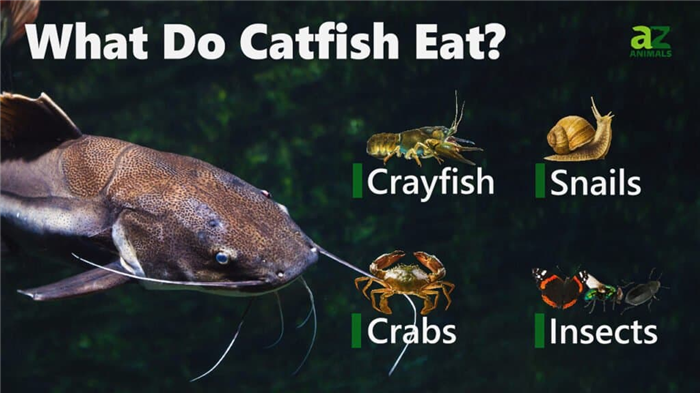
Catfish will scavenge for food and eat just about anything!
Catfish are fish characterized by long barbels coming out from the sides of their face, looking like cat whiskers. There are close to 3,000 species of catfish with the channel catfish being the most common. Most of the species live in freshwater, but there are some species like the hardhead catfish that live in saltwater. You are probably thinking catfish eat mouse fish (is that a thing?), but let’s find out what they do eat!
How do catfish eat?
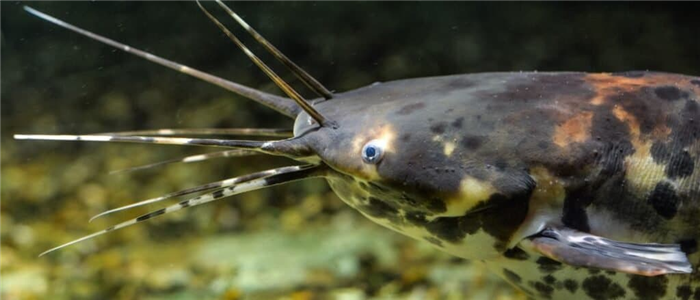
The barbells on a catfish’s face that are used to locate prey
Do catfish wait for food to come to them or do they actively seek out food? As scavengers they are always on the lookout for food. They seem to prefer fresh food but will also eat dead animals/fish that are available. Catfish use the barbels on their face to locate prey. The barbels have both taste and smell to help them find food in the dark muddy waters they typically live in.
What do catfish eat?
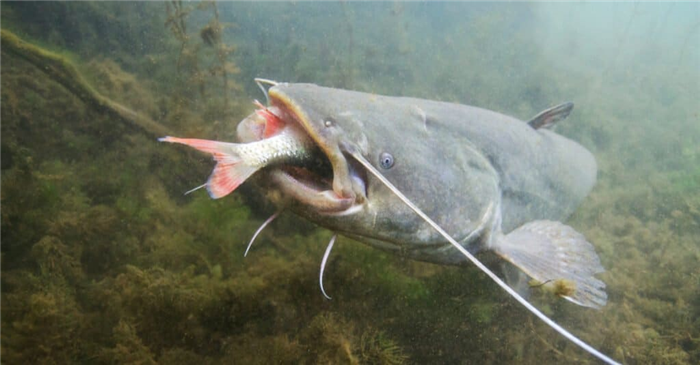
A catfish eating a small fish
Catfish are opportunistic feeders meaning they will adapt to the food that is currently available. They eat a variety of small fish, crayfish, snails, clams and frogs. They also will eat algae and the remains of dead fish and plants that are floating in the water. Headwater catfish, the ones that live in saltwater, will eat seagrass, sea cucumbers, shrimp and blue crabs.
A complete list of what Catfish eat:
- Crayfish
- Small fish
- Snails
- Clams
- Aquatic Insects
- Algae
- Frogs
- Detritus
- Phytoplankton
- Seagrass
- Sea Cucumbers
- Shrimp
- Blue Crabs
Young catfish and adult catfish diets do differ. In a study of channel catfish that was done in Central Italy researchers studied the diets of catfish to compare what they eat. What they found was that males and females seem to have similar diets, but young catfish and older catfish diets were different. The stomachs of the smaller catfish contained detritus (broken down parts of dead plants and animals) and phytoplankton (microscopic single-celled plants). The stomachs of the adult catfish contained topmouthed gudgeon (a small fish about the size of your index finger) and red swamp crayfish. Based on this research it appears that as the catfish can handle larger fish and crayfish as they themselves grow larger.
How do catfish fit into the ecosystem?
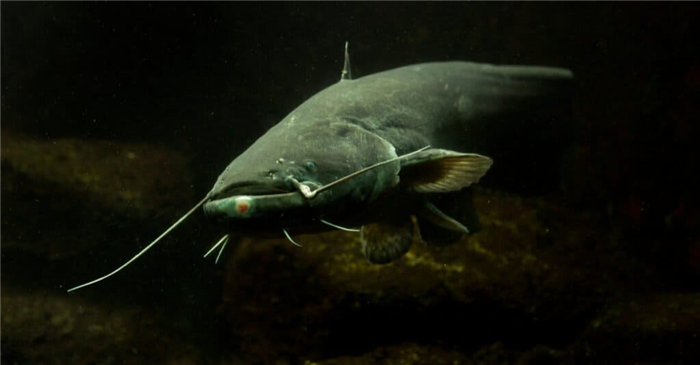
A wels catfish
According the NOAA, one variety of catfish, the blue catfish is considered an invasive species. In the Chesapeake Bay area, the Blue catfish are creating an imbalance in the food web. Because they can eat such a variety of foods they are growing in numbers. They also will challenge and win against larger fish which also upsets the food chain. There are established workgroups addressing the issue and coming up with a plan to manage the blue catfish population in that area.
What eats Catfish?
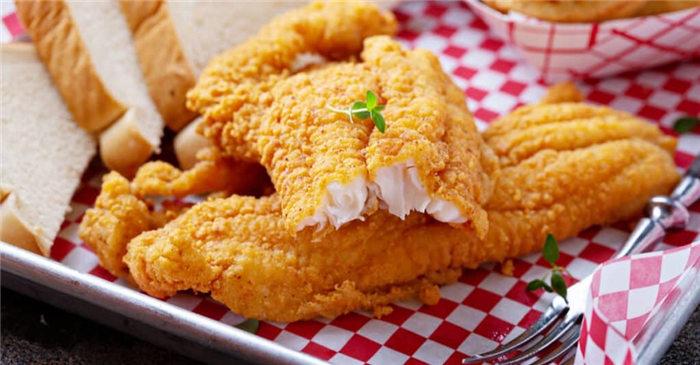
Catfish is commonly eaten in many cultures
Does Crispy Southern Fried Catfish sound good to you? That’s because it is delicious, making humans as one of the predators of catfish. Crocodiles, birds of prey and larger fish also eat catfish but they typically skip the Cajun seasoning!
Share this post on:
Cindy Rasmussen
I’m a Wildlife Conservation Author and Journalist, raising awareness about conservation by teaching others about the amazing animals we share the planet with. I graduated from the University of Minnesota-Morris with a degree in Elementary Education and I am a former teacher. When I am not writing I love going to my kids’ soccer games, watching movies, taking on DIY projects and running with our giant Labradoodle “Tango”.
Raising Catfish
Farm pond catfish get their nutrition from specially formulated pellets. These pellets should include a protein concentration of between 28 and 32 percent, according to William A. Wurts, an agriculturist with Kentucky State University, in a 2001 paper published in World Aquaculture. In addition, Wurts recommends feeding pellets that float when water temperatures reach 65 degrees Fahrenheit or more. Switch to slowly sinking pellets with water temperatures that fall between 60 and 65 degrees, and sinking pellets at water temperatures below 60 degrees.
Since catfish have such pronounced sensors for locating food, anglers select bait with strong, often unbearable odors. The scent spreads in water, attracting catfish to the food. Stink baits, chicken or other animal livers, and dough balls are possible baits. Catfish also take baits of live or cut fish, night crawlers and crayfish.
